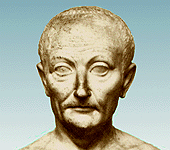The directory «Plots»
Publius Ovidius Naso
(43 B.C.–A.D. 18)

Latin poet, b. Sulmo (present-day Sulmona), in the Apennines. Although trained for the law, he preferred the company of the literary coterie at Rome. He enjoyed early and widespread fame as a poet and was known to the emperor Augustus. In A.D. 8, for no known reason, he was abruptly exiled to Tomis, a Black Sea outpost, S of the Danube, where he later died. The poems of Ovid fall into three groups—erotic poems, mythological poems, and poems of exile. His verse, with the exception of the Metamorphoses and a fragment (Halieutica), is in elegiacs, which are of unmatched perfection. The love poems include Amores [loves], 49 short poems, many of which extol the charms of the poet’s mistress Corinna, probably a synthesis of several women; Epistulae heroidum [letters from heroines], an imaginary series written by ancient heroines to their absent lovers; Ars amatoria [art of love], didactic, in three books, with complete instructions on how to acquire and keep a lover. In the mythological category is the Metamorphoses, a masterpiece and perhaps Ovid’s greatest work. Written in hexameters, it is a collection of myths concerned with miraculous transformations linked together with such consummate skill that the whole is artistically harmonious. The Fasti, also a mythological poem, contains six books on the days of the year from January to June, giving the myths, legends, and notable events called to mind on each day. As a source for religious antiquities, it is especially valuable. The poems of exile include Tristia [sorrows], five books of short poems, conveying the poet’s despair in his first five years of exile and his supplications for mercy, and the Epistulae ex Ponto [letters from the Black Sea], in four books, addressed to friends in Rome, showing somewhat abated poetic power. Ovid wrote poetry to give pleasure; no other Latin poet wrote so naturally in verse or with such sustained wit. Unsurpassed as a storyteller, he also related the complexities of romantic involvements with verve and deft characterization. A major influence in European literature, Ovid was also a primary source of inspiration for the artists of the Renaissance and the baroque. The Metamorphoses was translated during this period by A. Golding (1567), George Sandys (1632), and John Dryden (1700).
Albania, 1973, «Narcissus» (Caravaggio)
Fujeira, 1972, Danae
Gambia, 2000, Danae
Greece, 1958, Narcissus
Greece, 1985, Apollo and Marsyas
Guinea Bissau, 2008, Titien, «Danae»
Guinea Bissau, 2008, Paintings by Titian
Guinea Bissau, 2008, Titien, «Danae»
Guyana, 2004, «Mercury Takes Bacchus to be brought up by Nymphs» (Laurent de La Hyre)
Italy, 1957, Ovid
Luxemburg, 1977, «Orpheus and Eurydice»
Manama, 1971, Diana and Acteon
Nevis, 1991, The Feast of Acheloüs
Nevis, 1991, The Feast of Acheloüs
Paraguay, 1970, Danae
Paraguay, 1976, Venus and Adonis
Paraguay, 1976, Diana and Callisto
Paraguay, 1976, Perseus and Andromeda
Paraguay, 1986, Diana and Actaeon
Paraguay, 1986, Diana and Actaeon
Paraguay, 1986, Diana and Callisto
Paraguay, 1989, Death of Actaeon
Rumania, 1957, Monument of Ovid
Rumania, 1960, Monument to Ovid
Rumania, 2003, Map and staue of Ovid
Sao Tome e Principe, 2010, «Narcissus» (Caravaggio)
Tanzania, 1990, Venus and Adonis
Vatican, 1997, Bacchus riding dragon